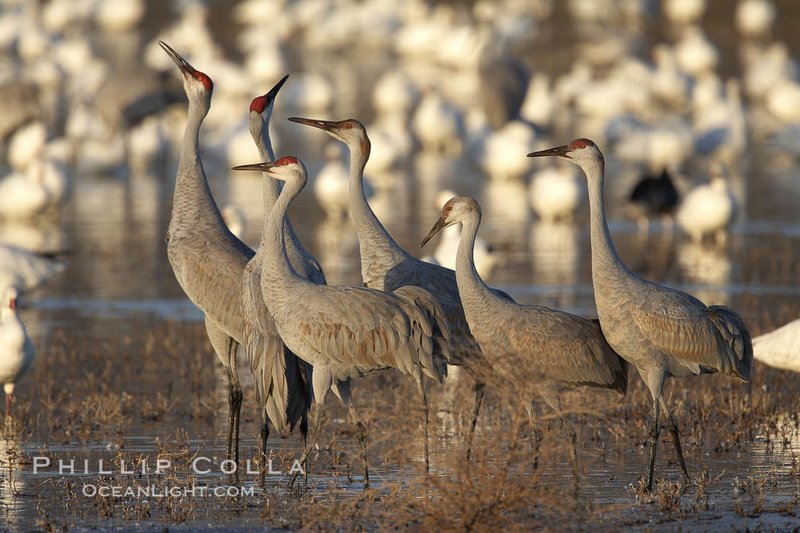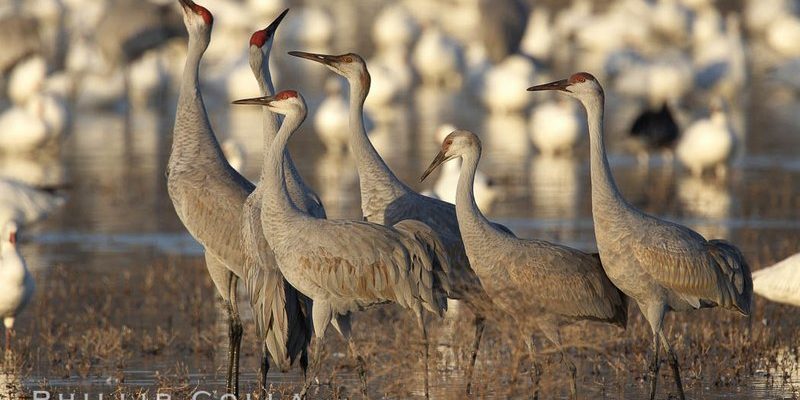
Have you ever seen a bird with legs that seem to go on for days, gracefully gliding through the air? That’s the Sandhill Crane for you! These magnificent birds are not just known for their size; they also have a rich history and a fascinating way of life. Imagine standing in a serene wetland, surrounded by the sound of their haunting calls—a mix of trumpets and whistles—echoing in the crisp air. It’s like nature’s very own symphony.
Sandhill Cranes are truly remarkable creatures. They captivate birdwatchers and nature enthusiasts alike with their elegance, social behavior, and migratory journeys. But there’s so much more to these birds than meets the eye. From their unique nesting habits to their striking appearances, let’s explore the world of the Sandhill Crane together.
Physical Characteristics
The Sandhill Crane is easily recognizable due to its tall stature, reaching heights of up to four feet. They have long, slender necks and legs, which allow them to wade gracefully through wetlands. Their wingspan can extend up to seven feet, making them one of the largest flying birds in North America. When they take flight, it’s a sight to behold; their massive wings create a powerful whooshing sound as they soar gracefully against the sky.
Most adult Sandhill Cranes are predominantly gray with subtle reddish hues on their heads and faces. This distinctive coloring makes them stand out, especially during the breeding season when their plumage can appear more vibrant. Interestingly, the younger cranes, called colts, are covered in soft, downy feathers that are a reddish-brown color—perfect for blending into their surroundings to avoid predators.
Another striking feature of the Sandhill Crane is its eye color. They have bright, expressive eyes, typically yellow or orange, which add to their charming appearance. Their long legs and necks allow them to forage for food in shallow waters, where they feed on a varied diet of seeds, grains, and small aquatic creatures. Overall, their physical characteristics play a significant role in their survival and adaptability.
Habitat and Distribution
Sandhill Cranes are found across North America, from the Gulf Coast to Canada and parts of Alaska. Their preferred habitats include wetlands, grasslands, and agricultural fields. These birds thrive in areas where they can find open water supplies for feeding and nesting. Wetland ecosystems provide the perfect environment for both adult cranes and their young colts as they grow and learn essential survival skills.
During migration, Sandhill Cranes travel thousands of miles from their breeding grounds to warmer winter habitats. They form large, noisy flocks that can fill the sky, creating a stunning spectacle as they move together in mesmerizing formations. Migration typically occurs twice a year, in spring and fall, and this journey is a vital part of their life cycle. If you’re ever near a wetland during migration season, you might witness these impressive flocks as they make their way to and from their chosen habitats.
Some of the most famous migration stops for Sandhill Cranes include the Platte River in Nebraska, where thousands gather during their spring migration. This natural phenomenon attracts birdwatchers from around the world who come to witness the breathtaking sight of these cranes resting and preparing for the next leg of their journey.
Diet and Feeding Behavior
When it comes to food, Sandhill Cranes are opportunistic feeders. They enjoy a varied diet that includes seeds, grains, roots, and tubers. These birds are often seen foraging in fields after a harvest, taking advantage of leftover grains. Imagine a group of cranes walking gracefully through a field, pecking at the ground for a tasty morsel—it’s a common sight in agricultural areas.
In addition to grains, Sandhill Cranes also feed on small animals such as insects, frogs, and even small fish when near water sources. Their long legs and sharp beaks make them excellent foragers, allowing them to sift through mud and water to find food. This adaptability in diet helps them thrive in various environments and ensures they can sustain themselves year-round.
Interestingly, Sandhill Cranes have a unique feeding behavior known as “dancing.” Not only is this a form of communication, but it also plays a role in courtship rituals. During feeding times, you might see a pair of cranes performing little hops and jumps while facing each other, showcasing their agility and grace.
Nesting and Reproduction
When it comes to nesting, Sandhill Cranes are quite dedicated. They typically mate for life and return to the same nesting sites year after year. Nests are usually built near the water’s edge, using reeds, grasses, and mud to create a sturdy foundation. The female usually lays two eggs, which both parents take turns incubating for around 30 days.
Once hatched, the colts are precocial, meaning they’re relatively mature and mobile shortly after birth. They can walk, swim, and forage for food within hours of hatching. This ability to fend for themselves is crucial, as they need to grow quickly to evade potential predators. Over the next few months, the colts will learn essential survival skills as they accompany their parents through the wetlands.
Raising young takes a lot of teamwork. Both parents are involved in protecting and feeding their young. They’ll often lead their colts to safe feeding areas, showing them how to find food and navigate their habitat. The strong bond between the parents and their young ultimately ensures the survival of the next generation.
Social Behavior and Communication
Sandhill Cranes are highly social birds. They often gather in large flocks, especially during migration and at communal roosting sites. These gatherings serve several purposes, from socializing to mating displays. Crane gatherings can be quite lively, with the birds engaging in various behaviors, including preening, dancing, and calling to one another.
Speaking of calls, Sandhill Cranes are known for their distinctive vocalizations. Their calls are loud and resonate over long distances, often described as a trumpeting sound. This unique communication is essential for maintaining social bonds within the flock and during the breeding season to attract mates. You might even hear them communicating back and forth, creating an enchanting natural melody.
During courtship, pairs will perform elaborate dances that include hopping, bowing, and even wing flapping. These displays are not only a way for cranes to bond but also serve to strengthen their pair’s connection before nesting begins. The choreography of their dance is mesmerizing, showcasing their grace and agility.
Conservation Status
The status of the Sandhill Crane varies significantly by population. Some populations, like the Greater Sandhill Crane, are currently stable and even increasing, thanks to conservation efforts and habitat protection. However, others, like the Florida Sandhill Crane, are considered endangered due to habitat loss and human encroachment into their breeding and feeding areas.
Conservation organizations are actively working to protect these magnificent birds. Efforts include habitat restoration, creating protected nesting areas, and educating the public about their importance in ecosystems. Community involvement is crucial, as local efforts can significantly contribute to the survival of Sandhill Cranes.
As birdwatchers and nature enthusiasts, we can also do our part. Promoting awareness about these birds and advocating for their habitats can help ensure that future generations will be able to enjoy the beauty and majesty of the Sandhill Crane. They are more than just beautiful birds; they symbolize the richness of our wetlands and the importance of preserving our natural world.
Fun Facts About Sandhill Cranes
- The Sandhill Crane is one of the oldest bird species, with fossil records dating back over 2.5 million years!
- They can fly at altitudes of 15,000 feet during migration, making them one of the highest-flying birds in North America.
- These cranes are known for forming strong monogamous bonds and can live for over 20 years in the wild.
- Sandhill Cranes are also famous for their “dancing” behavior, which plays a role in courtship and social interactions.
Sandhill Crane in Culture
Across various cultures, Sandhill Cranes hold significant meanings and symbolize various themes, such as longevity, happiness, and fidelity. In Native American cultures, these birds are often seen as messengers between the physical world and the spiritual realm. Their elegant movements and distinct calls have inspired folklore, art, and literature.
In Japan, the crane is a symbol of good fortune and longevity, often depicted in traditional art. The famous origami crane is a representation of peace and hope, stemming from the belief that folding one thousand paper cranes can grant a wish. It’s fascinating how a bird can hold such cultural significance across different societies!
Modern conservation efforts also recognize the importance of Sandhill Cranes. Festivals celebrating their migrations and the beauty of these birds create awareness and foster appreciation among communities. These events bring people together to admire the cranes while promoting conservation efforts to protect their habitats.
FAQ
What is the lifespan of a Sandhill Crane?
Sandhill Cranes typically live for around 20 to 30 years in the wild, although some have been known to live even longer with good conditions and minimal threats. Their longevity can be attributed to their skills at foraging for food and their social behaviors, which help protect them from predators.
How do Sandhill Cranes find their mates?
Sandhill Cranes often perform elaborate courtship dances to attract mates. These displays include jumping, bowing, and calling. The physical act of dancing helps strengthen the pair bond, making these cranes lifelong partners.
Are Sandhill Cranes protected by law?
Yes, Sandhill Cranes are protected under the Migratory Bird Treaty Act, which safeguards them and their habitats. This law makes it illegal to hunt or harm them in many areas, emphasizing the importance of conserving these beautiful birds.
Can you spot Sandhill Cranes in urban areas?
While Sandhill Cranes prefer wetlands and open fields, they can sometimes be spotted in urban settings, especially if there are suitable green spaces or water sources nearby. They are adaptable birds and can thrive in a variety of environments, making them somewhat more visible to people.
What do Sandhill Cranes eat?
Sandhill Cranes have a diverse diet that includes seeds, grains, insects, small mammals, and aquatic invertebrates. They are skilled foragers and can often be seen searching for food in wetlands, agricultural fields, and grasslands.
Why do Sandhill Cranes migrate?
Sandhill Cranes migrate to take advantage of seasonal changes in food availability and breeding conditions. They travel south to warmer climates in the winter, where food is more abundant, and return to northern breeding grounds in the spring to raise their young.
How can I help protect Sandhill Cranes?
You can help protect Sandhill Cranes by supporting conservation organizations and habitat protection efforts. Raising awareness about their importance in ecosystems and advocating for natural areas can contribute to their survival. Participating in birdwatching events and festivals can also help spread the word about these magnificent birds.
Are Sandhill Cranes social birds?
Yes, Sandhill Cranes are very social creatures. They often gather in large flocks, especially during migration and at communal roosting sites. Their social behaviors include communicating through vocalizations, dancing, and grooming one another, which strengthens their bonds.
How do Sandhill Cranes communicate?
Sandhill Cranes have a range of vocalizations that they use to communicate. Their calls are loud and can carry for miles, allowing them to stay in touch with their flock members. They use different calls for various purposes, such as attracting mates, signaling danger, or calling to one another in flight.
What threats do Sandhill Cranes face?
Sandhill Cranes face several threats, including habitat loss due to urban development and agriculture. Climate change also poses risks to their migratory patterns and food sources. Conservation efforts are vital to mitigate these threats and ensure their populations remain stable.
Why are Sandhill Cranes important to ecosystems?
Sandhill Cranes play a crucial role in their ecosystems by helping to maintain the balance of wetland habitats. By foraging and feeding, they contribute to seed dispersal and nutrient cycling, which benefits other species and promotes biodiversity.

